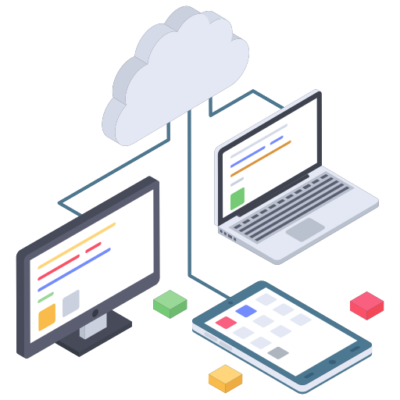What is Internet of Things?
The Internet of Things (IoT) refers to the interconnection of everyday objects, devices, and appliances with the internet and other networked systems. IoT devices can be embedded with sensors, processors, and connectivity technology that enable them to collect, analyze, and exchange data with other devices and systems over the internet.
The goal of IoT is to create an interconnected network of smart devices that can automate and streamline various tasks, such as monitoring and controlling home appliances, tracking inventory and supply chains, and optimizing industrial processes. IoT applications can be found in a wide range of industries, including healthcare, transportation, energy, and agriculture.
Examples of some IoT devices
-
- Smart Home Devices: These are devices designed for use in the home, such as smart thermostats, smart lighting, and smart security systems.
- Wearable Devices: These are small devices that are worn on the body, such as fitness trackers and smart watches.
- Connected Vehicles: These are vehicles equipped with sensors and connectivity technology that enable them to communicate with other vehicles and the surrounding infrastructure.
- Industrial IoT Devices: These are devices used in industrial settings, such as sensors that monitor equipment performance and optimize production processes.
- Healthcare IoT Devices: These are devices used in healthcare settings, such as wearable health monitors and remote patient monitoring systems.
- Smart City Devices: These are devices used in smart city infrastructure, such as smart streetlights and intelligent traffic systems.
- Agricultural IoT Devices: These are devices used in agriculture, such as sensors that monitor soil moisture levels and weather conditions to optimize crop production.
Sample Project
It is on edge AI that uses TensorFlow Lite to run an image classification model on a Raspberry Pi. In this project, we will be using a pre-trained image classification model to identify objects in an image. We will be running this model on a Raspberry Pi using TensorFlow Lite, which is a lightweight version of the popular TensorFlow deep learning library designed specifically for mobile and embedded devices.
Project Overview
In this project, we will be using a pre-trained image classification model to identify objects in an image. We will be running this model on a Raspberry Pi using TensorFlow Lite, which is a lightweight version of the popular TensorFlow deep learning library designed specifically for mobile and embedded devices.
Prerequisites
-
- A Raspberry Pi with a camera module
-
- Python 3.x installed on the Raspberry Pi
-
- TensorFlow Lite installed on the Raspberry Pi
-
- A pre-trained TensorFlow Lite image classification model
Project Steps
1. Set up the Raspberry Pi
First, we need to set up the Raspberry Pi with the necessary software. To install TensorFlow Lite on the Raspberry Pi, open a terminal window and enter the following command:
sudo pip3 install https://dl.google.com/coral/python/tflite_runtime-2.5.0.post1-cp37-cp37m-linux_armv7l.whl
This will install TensorFlow Lite on the Raspberry Pi.
2. Load the model
Next, we need to load the pre-trained TensorFlow Lite image classification model. We can do this using the following code:
import tensorflow as tf# Load the TFLite model and allocate tensors.interpreter = tf.lite.Interpreter(model_path="model.tflite")interpreter.allocate_tensors()# Get input and output tensors.input_details = interpreter.get_input_details()output_details = interpreter.get_output_details()
Replace model.tflite with the filename of your pre-trained TensorFlow Lite model.
3. Capture an image
We need an image to classify, so we will capture an image using the Raspberry Pi camera module. We can do this using the following code:
from picamera import PiCamera# Create a PiCamera object.camera = PiCamera()# Capture an image.camera.capture("image.jpg")
This will capture an image and save it as image.jpg in the current directory.
4. Preprocess the image
Before we can feed the image into the model, we need to preprocess it to match the input requirements of the model. We can do this using the following code:
import numpy as npfrom PIL import Image# Load the image and resize it to the required size.image = Image.open("image.jpg").resize((224, 224))# Convert the image to a numpy array.image_array = np.array(image)# Normalize the image.normalized_image_array = (image_array.astype(np.float32) / 127.0) - 1# Add a batch dimension to the image.input_data = np.expand_dims(normalized_image_array, axis=0)
Replace 224 with the input size required by your TensorFlow Lite model.
5. Run the model
Now we can run the TensorFlow Lite model on the preprocessed image. We can do this using the following code:
# Set the input tensor.interpreter.set_tensor(input_details[0]['index'], input_data)# Run the model.interpreter.invoke()# Get the output tensor.output_data = interpreter.get_tensor(output_details[0]['index'])
This will run the model and get the output tensor.
6. Interpret the results
Finally, we need to interpret the results of the model. We can do this using the following code:
# Get the predicted class.predicted_class = np.argmax(output_data)# Print the predicted class.print("Predicted class:", predicted_class)
This will print the predicted class of the image.
That’s all for this post!
You can also visit Edge Impulse AI platform to check some interesting projects: https://www.edgeimpulse.com/
You can also check some interesting posts on machine learning from blog page: https://ai-researchstudies.com/blog/
If you like the blog please subscribe it to receive notification about upcoming posts!
Happy reading!!
Thank you.


